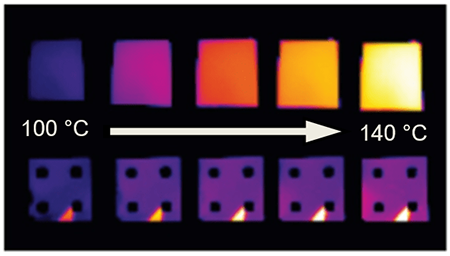| Aug 11, 2021 |
Quantum materials cloak thermal radiation
(Nanowerk News) Scientists demonstrated that ultrathin films of samarium nickel oxide can mask the thermal radiation emitted by hot materials. Samarium nickel oxide is a quantum material. These are materials that have strange and incredible properties due to quantum mechanics.
|
|
The cloaking mechanism is due to the material undergoing a unique, gradual transition from insulator to heat-conducting metal. This transition occurs over a temperature range from 100 to 140 degrees centigrade.
|
 |
| Thermal images of samples heated from 100 to 140 degrees C. The top row shows a material heating with increasing temperature. The bottom row shows the same material coated with ultrathin samarium nickel oxide films that cloak the thermal emission. (Image: A. Shahsafi, University of Wisconsin-Madison)
|
|
This study (PNAS, "Temperature-independent thermal radiation") shows that quantum materials can manage thermal radiation. This ability could advance applications such as infrared camouflage, privacy shielding, and heat transfer control.
|
|
The 100-140 degree centigrade heat range is important because it can be seen with infrared cameras.
|
|
Conventional wisdom states that the hotter an object is, the brighter it glows. This is the case for thermal light at any wavelength and enables applications such as infrared imaging and noncontact thermometry.
|
|
However, researchers at the Department of Energy (DOE) Center for Functional Nanomaterials at Brookhaven National Laboratory demonstrated a coating that emits the same amount of thermal radiation regardless of temperature, within a temperature range of about 30 degrees centigrade.
|
|
This is accomplished using samarium nickel oxide—a quantum material that changes strongly but gradually as a function of temperature. This is the first time researchers have demonstrated temperature-independent thermal radiation.
|
|
The results have substantial implications for infrared camouflage, privacy shielding, and radiative heat transfer.
|

